Reproduction in Bacteria
Reproduction is a process that led to the formation of offspring. Reproduction result in variation of particular species. It can be of two types that are Asexual and Sexual Reproduction. In sexual reproduction, the parent organism transmits the genetic material to their progeny.
However, in asexual reproduction, the parent produces genetically identical progeny. It is a process where one copy of parent produces similar progeny to itself. Example of such asexual reproduction is Volvox.
Bacterial Reproduction
Just like any other living organism, bacteria also do reproduce to maintain their species in the population. The bacteria are unicellular organism and do not contain well defined nucleus in the cell. So, they have grouped under prokaryotes organism. A bacterial population grow in exponential mean increasing rate, in which each cell division produce daughter cell in fashion of two, four, eight, sixteen, thirty-two cells and so on.
However, they execute both sexual and asexual modes of reproduction. In this article, we will have a brief overview of all the mode of reproduction in bacteria. In asexual reproduction, there are various method from which a bacteria can reproduce their progeny. Sexual reproduction has five types of means such as Binary fission, budding reproduction, Reproduction through conidia, Bacterial reproduction through cyst formation and endospore formation. Here, we will study all the subtypes of asexual reproduction in bacteria.
Asexual Reproduction Methods
Binary Fission
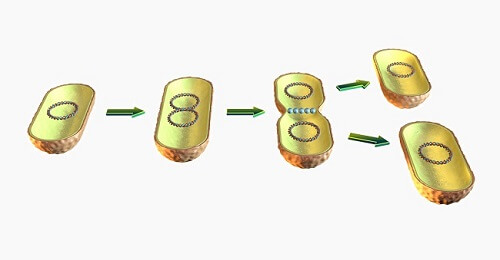
Binary fission is an asexual mode of reproduction. In the process of binary fission, A single bacteria divides into two daughter cells. Firstly, the bacterial will make a compact mass of cell with its components. Here, the circular double stranded DNA do replication and new complementary strands are generated. These two complementary strands of DNA are then separated and move to opposite poles of the cell and new septum is formed transversely which develops in the center of cell separating the two daughter cells. Thus, the binary fission is completed.
Binary fission is fastest process and takes only minutes to complete their cycle. Binary fission is adopted by many bacteria including Salmonella and E. coli.
The unicellular DNA duplicates in the asexual reproduction process where the single DNA grows as the cell develops and elongates. The cell membrane tweaks inside toward the middle of the bacteria once the size of cell has become doubled.
Conidia formation
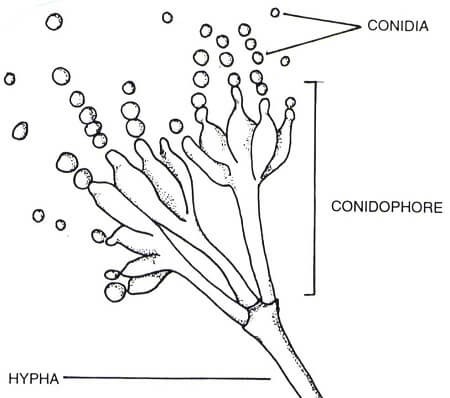
The condos formation occurs in filamentous type of bacteria such as streptomyces through the development of transverse septum at the terminal of the filament. The conidia formation takes place in the fruiting body called Conidiophores and after the detachment of Conidiophores from the mother cell in a suitable substratum, it gives rise to formation of new mycelium. This kind of asexual reproduction takes place in fragmentation process.
Most common example of Conidia formation is Streptomyces (filamentous bacteria). Conidia are minute, spherical, chain like structure, spore like body formed by the transverse septum at the Apex of filament.
Conidiophore is a structure that contains conidia (spore like structures). Each conidia get removed from the mother cell and give rise to new mycelium in a suitable substratum.
Budding

Budding is an asexual reproduction where the bacterial cell generates small outgrowth or bud by cell division at a single location. These buds later grow into individuals and the nucleus divide at the same time when the bud was getting separated by its mother cell. However, some part of nucleus with small amount of cytoplasm goes into new formed bud. When it reaches maturity, it gets separated.
In this asexual mode of reproduction, the bacteria cell protrudes out small structure at one side which continuously grow and increase in size. Subsequently, the nucleus of the bacterial cell also undergoes division where some part of the nucleus along with cytoplasm goes into that small protruding structure while the other part of nucleus remains in the mother cell. This developing outgrowth is referred to as bud and eventually the bud gets detached from the mother cell by the transverse septum.
Budding also comes under vegetative propagation in bacteria. The common example of budding in bacteria is Rhodomicrobium vannielii.
Cysts Formation
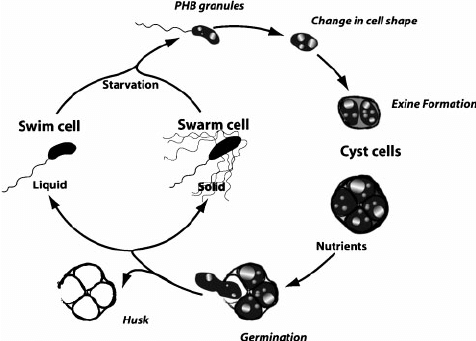
Cyst formation takes place by the accumulation of extra layers around the mother cell and the resting structure during stressful or unfavorable conditions. And when conditions are suitable again, the mother cell operates the normal cell. Cysts are known as the inactive or resting stage of mother cells.
Cysts are formed by the additional layer which gets deposited around the mother cell wall. At this stage, the metabolism of cell gets slow. However, when cells are at favorable condition, they use a process where the Wall’s cyst get break down and produce a new bacterium. This process is called excystation. The main function of cyst is to protect the cell from harmful conditions and environment change. Most common example of cyst formation in bacteria is Azotobacter.
Reproduction Through Endospore Formation
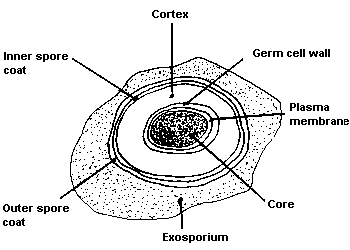
Endospore formation takes place in the bacterial cell during unfavorable conditions such as nutrient depletion, starvation and desiccation. Endospores contain protoplast in the center and core structure contains DNA, ribosomes enzymes and transfer RNA that contribute to the formation of new cell. One bacteria cell produces only one endospore and on germination, it germinates the new bacterium.
Bacteria does not execute the sexual reproduction in the same way that eukaryotic organisms do. They have no separation between a diploid and haploid generation, and no meiosis. However, genetic recombination is very crucial to sexual reproduction, and the bacteria have three methods to produce recombinants. These include transformation, conjugation and transduction.
Sexual Reproduction Methods
Transformation
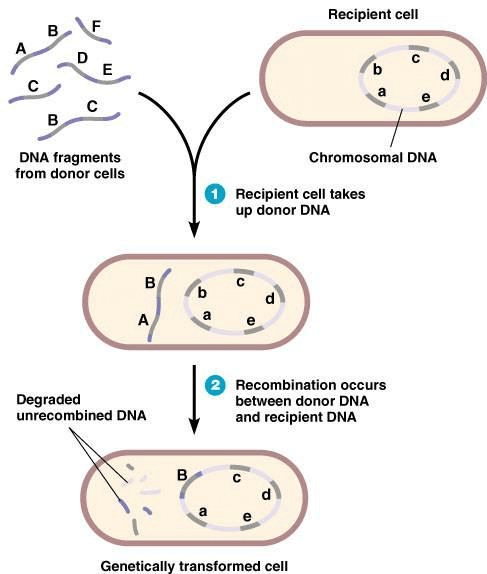
Many bacteria have the ability to acquire DNA or plasmid from their surroundings. The ability to easily transform the bacterium E. coli has made the cloning of genes such as human genes possible. Transformation has taken the area of biotechnology industry to next step.
The transformation process was first introduced in Streptococcus pneumoniae which led to the discovery that DNA is the genetic material in many organism excluding viruses because they contain both DNA and RNA as their genetic material. The discovery of transformation through an experiment stated in 1928 by the English bacteriologist Fred Griffith.
The cells of Streptococcus pneumoniae are generally covered by a capsule made of polysaccharide. When they grow on culture of solid medium, the capsule gives smooth, glistering appearance to the colonies of bacteria. These cells are referred as S cells. Although, after long culture of bacterial cells in artificial medium, some of the cells lose the capsule producing ability, which causes the surface to appear wrinkled and rough. These cells are called R cells. Additionally, absence of capsule cause loses in the virulence of bacterial cells.
When single S. pneumoniae injected into a mouse that will kill the mouse within 24 hours or more. But when injected with more than 100 million R cells into a mouse, the mouse will survive.
The capsule prevents the bacterium from getting engulfed and destroyed by scavenging cells, and other neutrophils and macrophages. Pneumococci have more than 90 different types like I, II, III and like that. The type of cells differs in the biostructure of the polysaccharide constitute in the capsule.
But Griffith investigated that when living R cells (non-virulent) and dead S cells (non- virulent) were injected together in the mouse, the mouse survived but become ill and the living S cells can be recovered from the body.
Moreover, when living R -I cells and dead S cells injected into the mouse, it gets killed with the living S pneumococci cells. Experimental results concluded that something in the dead S cells had made change in the phenotype of R cells. This process is later referred as Transformation.
Then, Oswald Avery and his colleagues from the Rockefeller Institute in New York City later stated that “something” was DNA. They investigated that DNA was the genetic material.
In continuation of Griffith experiment, Avery and his colleagues thought that they could bring the same transformation in-vitro using the bacterial cell extract. They treated the extract with:
- Enzyme destroying the polysaccharide molecule constituting the bacterial capsule.
- Use of Solvents that eliminate lipids in capsule
- Use RNAse to dissolve RNA.
They found that it didn’t make the extracts unable to transform the bacteria. However, treating the bacterial extract with DNAse to destroy the DNA, interestingly this stopped the transformation activity. So, they made conclusion that DNA was the genetic material in the dead cells that were carrying out the transformation activity from in them. So, DNA is that substance of genes.
Although, the chemical constituents of the capsule are determined by genes producing them. The phenotype of polysaccharide molecules in the capsule were determined by the specific enzymes that synthesis polysaccharide. DNA is converted into RNA through transcription process and later RNA gets converted into protein through translation process.
Avery and his colleagues Colin MacLeod and Mc Carty submitted their commendable work on February 1,1944. However, their immense contribution to science through their finding was not highly appreciated by other scientists and was not considered by the Nobel Committee. Unfortunately, Mc Avery died before their work could be honored with Nobel Prize.
Conjugation
Some bacteria such as E. coli can transfer a part of their DNA from donor cell to the recipient cell through a direct cell to cell contact. The cell replicates its DNA (donor cell), the copy is transformed into the recipient cell. If the donor and recipient cell get separated, the transfer of genes will terminate. Those genes that successful get inserted into the recipient cells, replace the chromosome of recipient cell.
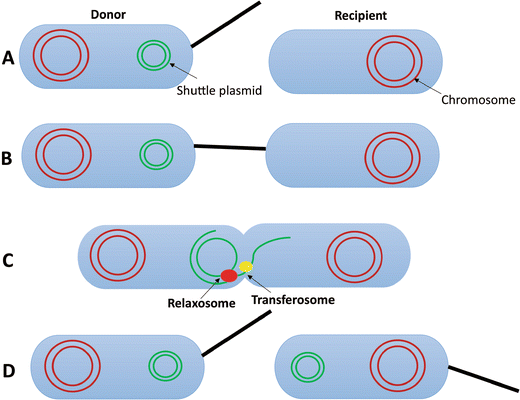
The conjugation can only happen between two opposite mating cell types such as Donor or male which carry a fertility factor (F+) and the recipient or female cell which does not carry fertility factor (F-). The set of genes acquired from plasmid and then get integrated into the bacterial chromosome is called fertility factor. It found the origin of replication for the chromosome. A part of F factor called Locomotive which pulls the chromosome into the recipient cell while the other remaining part is called Caboose.
In E. coli bacteria, one gene transfer in a second that makes the cell to stay together. So, 100 minutes takes to transfer the entire genome which is around 4377 genes. However, the process can be easily interrupted.
When they cultured together, the male donor transfers The and Leu functional genes into some of the female cells. Double crossover event allows them to replace the non- functional alleles. So that the cells can grow successfully on minimal medium with glucose and salts composition.
Transduction
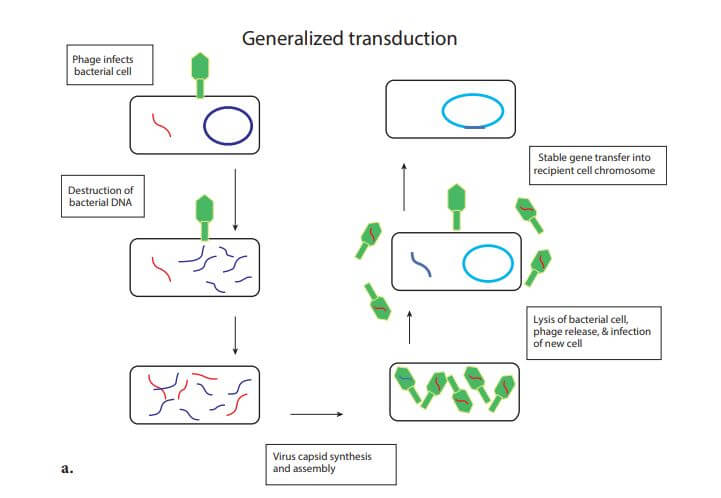
In this process, bacteriophages are involved. Bacteriophages are the type of viruses that infect bacteria. It is a process of assembling new virus particles, host cell DNA that gets incorporated in them. The head which is called capsid of virus carry DNA so that they can infect the host cell and lyse them.
Instead, the bacterial genes may be inserted with DNA of the new host replacing the DNA of already existing and giving the host an altered phenotype. This process is called Transduction.
